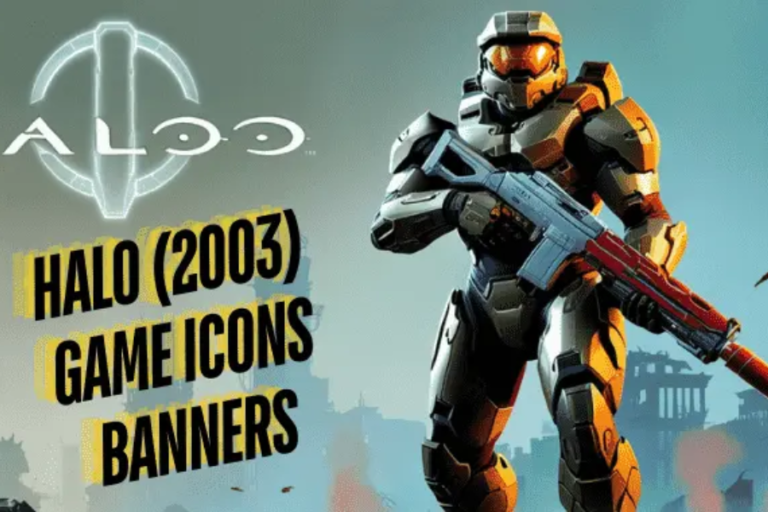halo (2003) game icons banners: A Comprehensive Guide
halo (2003) game icons banners: Combat Evolved, released in 2001 for the Xbox and later on PC, changed the landscape of first-person shooters and established a legacy that spans across the gaming world. By 2003, Halo had fully cemented itself as a cornerstone of halo (2003) game icons banners modern gaming culture, setting the stage for everything from competitive multiplayer arenas to iconic gaming visuals. Part of what made the game so memorable was its unique design language, particularly its game icons and banners, which became symbols for an entire generation of gamers.
In this in-depth article, we’ll explore the history, development, and significance of Halo’s game icons and banners. We’ll dive into the artistic elements that made these visuals stand out, how they evolved with the franchise, and the lasting influence they continue to halo (2003) game icons banners have in gaming culture today. We’ll also discuss the process behind creating these graphics, examining how they contribute to the overall aesthetic and immersive experience that Halo offers. By the end of this article, you’ll have a newfound appreciation for the iconic banners and logos of Halo, and the role they play in defining one of the greatest games in history.
The Origins of Halo: Combat Evolved and Its Iconic Visuals

Halo’s Beginnings: Setting the Scene in 2001
When Bungie developed Halo: Combat Evolved, the game was initially conceived as a real-time strategy game for the Mac. However, its destiny took a different halo (2003) game icons banners turn when Microsoft acquired Bungie in 2000, transforming Halo into an exclusive first-person shooter for the original Xbox console. Upon its release in 2001, Halo was met with universal acclaim, thanks to its gripping story, expansive world, and revolutionary gameplay mechanics. While gameplay took center stage, the visual identity of Halo became equally important.
The visual elements, including the game’s icons and banners, were meticulously crafted to reflect its futuristic, militaristic, and otherworldly themes. These elements halo (2003) game icons banners were not just static designs but active contributors to the player’s immersion in the game’s universe. The bold typography, vivid colors, and sharp iconography instantly became synonymous with the Halo experience.
Early Game Icons: What Made Them Unique?
The early game icons of Halo: Combat Evolved were designed to be functional and aesthetically pleasing. Each icon, from the health bar to the weapon selection wheel, halo (2003) game icons banners was carefully crafted to be intuitive and easily recognizable. The art team at Bungie paid close attention to the shape, color, and texture of each icon to ensure that they not only fit within the game’s science-fiction world but also enhanced the player’s understanding of the game mechanics.
For example, the health meter, which used a segmented shield design, communicated the player’s vitality in a sleek and futuristic manner. The icons for weapons like the halo (2003) game icons banners assault rifle, plasma pistol, and energy sword were designed to reflect their in-game counterparts, blending realism with the artistic style of the Halo universe.
Banners as Symbols: Representation Beyond Gameplay
Banners in Halo were another key element of its design. In both the campaign and multiplayer modes, banners served as visual representations of various halo (2003) game icons banners factions, squads, and achievements. Whether it was the insignia of the UNSC (United Nations Space Command) or the Covenant’s alien symbols, these banners were more than just decorative elements—they provided important narrative context for the player.
From a design perspective, these banners conveyed a sense of grandeur and depth. The UNSC’s eagle symbol, for instance, reflected human resilience and military halo (2003) game icons banners strength, while the Covenant’s sleek, alien glyphs hinted at their advanced technology and ancient culture. These banners weren’t just arbitrary designs; they were visual representations of the ideological conflicts at the heart of Halo’s story.
Iconography and Design Elements in Halo (2003)
Minimalist yet Impactful Design
One of the defining aspects of Halo’s iconography was its minimalist design. While the game featured a rich and expansive world, the icons and banners halo (2003) game icons banners used a clean, streamlined style that conveyed information without overwhelming the player. This was particularly important given the fast-paced nature of Halo’s gameplay, where players needed to quickly process visual information.
For instance, the weapon icons were simplistic but instantly recognizable. Whether a player was using a human weapon like the pistol or a Covenant weapon like the needler, halo (2003) game icons banners the iconography was consistent with the game’s aesthetic. This minimalist approach extended to the HUD (Heads-Up Display), where health, shields, and ammo were presented in a clear, unobtrusive manner.
Color Schemes and Visual Hierarchy
The color schemes used in Halo’s icons and banners played a crucial role in guiding the player’s experience. For human elements like the UNSC, darker, more halo (2003) game icons banners military-like colors such as navy blue and olive green were used, evoking a sense of ruggedness and durability. On the other hand, the Covenant’s color palette included more vibrant, alien colors like purple and turquoise, highlighting their advanced and otherworldly nature.
Visual hierarchy also played a role in the iconography. halo (2003) game icons banners Important icons, like those indicating an objective or a key location, were designed to stand out immediately to the player. Bungie’s art team employed techniques like contrast and spacing to ensure that these critical icons were easily distinguishable from the rest of the interface.
Icon Evolution: From 2001 to 2003
Between 2001’s Combat Evolved and Halo’s subsequent expansions and sequels in 2003, the game’s visual style continued to evolve. The basic icon designs remained halo (2003) game icons banners consistent, but Bungie made subtle refinements to improve clarity and functionality. These tweaks were often influenced by player feedback, demonstrating Bungie’s commitment to improving the player experience without sacrificing the iconic look that Halo had established.
For example, in Halo’s multiplayer modes, the team icons were refined to offer clearer distinction between the Red and Blue teams. The banners used to represent halo (2003) game icons banners each team were made bolder and more vibrant, reducing any confusion in fast-paced gameplay scenarios. These updates showed how Halo’s visual identity was both static and dynamic, retaining core elements while adapting to new challenges and player needs.
The Role of Banners in Multiplayer Modes
A New Identity for Every Player
Banners played a crucial role in Halo’s multiplayer modes, offering a sense of identity and customization for players. Whether it was in local LAN halo (2003) game icons banners parties or online matches, the ability to personalize your multiplayer profile with specific banners became a core feature of the multiplayer experience.
These banners allowed players to showcase their achievements, rank, and allegiances. A player who had completed all the campaign levels on Legendary halo (2003) game icons banners difficulty, for example, could display a rare banner that was only unlocked by overcoming Halo’s toughest challenges. The prestige associated with certain banners created a sense of competition and pride within the Halo community.
Faction-Based Banners and Their Significance
In Halo’s multiplayer modes, factions played an important role in shaping the player’s experience. Faction-based banners helped solidify a halo (2003) game icons banners player’s alignment, whether they fought for the UNSC or the Covenant. The design of these banners was deliberate, incorporating elements that reflected each faction’s philosophy, technology, and history.
The UNSC banners, for instance, often featured military insignias, stars, and stripes, evoking imagery that was closely tied to real-world military symbolism. halo (2003) game icons banners The Covenant banners, by contrast, were more abstract, with angular designs and alien symbology that emphasized the faction’s mysterious origins and religious zealotry. These faction banners were not just aesthetic choices; they were integral to the storytelling within the multiplayer world, giving players a visual reminder of the conflict at the heart of Halo’s universe.
The Evolution of Multiplayer Banners in 2003
As Halo’s multiplayer modes became more competitive and popular in 2003, Bungie responded by expanding the range of banners available to players. halo (2003) game icons banners With the rise of online play, new icons and banners were introduced to reward different achievements. Whether a player earned a specific number of headshots or led their team to victory in capture-the-flag, these in-game accomplishments were visually represented through personalized banners.
This evolution of multiplayer banners was important for player engagement, encouraging gamers to continually strive for new achievements. Bungie’s halo (2003) game icons banners decision to expand the visual rewards system for multiplayer further deepened Halo’s immersive multiplayer experience, making the banners a symbol of status and skill in the community.
Cultural Impact of Halo’s Game Icons and Banners
Iconography as a Symbol of Gaming Culture
By 2003, Halo had transcended the gaming world and became a cultural phenomenon. Its icons and banners were no longer just visual elements within a video game; they became symbols of an entire gaming era. From fan halo (2003) game icons banners art to merchandise, the iconic designs from Halo were replicated across various mediums, cementing their place in popular culture.
The UNSC logo, the Spartan helmet, and even the energy sword became instantly recognizable symbols, even to people who had never played the game. halo (2003) game icons banners These icons were often used in advertising campaigns, fan communities, and gaming events, further spreading Halo’s visual identity beyond the screen.
Banners in Esports and Competitive Gaming
With the rise of esports and competitive gaming, Halo’s banners took on even greater significance. In professional tournaments and LAN events, halo (2003) game icons banners banners became a way for teams to showcase their identity and build a brand. Teams would often design custom banners based on Halo’s existing iconography, incorporating elements from the game’s design while adding their unique twist.
These custom banners became a crucial part of team branding in competitive play, offering a visual identity that players and fans could rally behind. halo (2003) game icons banners Whether it was a banner representing a team’s dominance in Slayer matches or their mastery in objective-based modes, the visual designs from Halo’s world became intertwined with the growing world of esports.
Fan-Made Icons and Community Contributions
The Halo community has always been one of the most dedicated in gaming, and this passion extended to the creation of fan-made icons and banners. halo (2003) game icons banners Using the tools Bungie provided, as well as third-party software, fans began creating their own custom banners to represent their clans, squads, and personal achievements. Many of these designs were inspired by the game’s official artwork, but they often incorporated new elements, blending Halo’s visual style with fan creativity.
The ability for fans to create their own banners and share them within the community helped keep the Halo experience fresh and engaging. It also halo (2003) game icons banners demonstrated the flexibility and enduring appeal of Halo’s design language, which could be adapted and reinterpreted by fans in countless ways.
The Legacy of Halo’s Visual Design
Influence on Other Games
Halo’s visual design, including its icons and banners, halo (2003) game icons banners has had a lasting influence on the gaming industry. Many games that followed borrowed elements from Halo’s clean, minimalist approach to HUD design, as well as its use of icons to communicate important information quickly and efficiently.
The success of Halo’s multiplayer modes also inspired other developers to focus on player identity and customization through banners, emblems, and badges. halo (2003) game icons banners Games like Call of Duty, Destiny (which was also developed by Bungie), and even Fortnite have implemented similar systems for player customization, where visual icons and banners become symbols of achievement and skill.
Continuing the Tradition in the Halo Franchise
The Halo franchise has continued to evolve, with each new entry building upon the iconic visual designs established in the original Combat Evolved. halo (2003) game icons banners While the core elements of the game’s icons and banners have remained consistent, each new game introduces its own visual updates, reflecting the advancements in technology and design.
In Halo 3, for example, the multiplayer banners became even more customizable, allowing players to create unique emblems and insignias. Halo 5: halo (2003) game icons banners Guardians introduced a more dynamic visual system, where players could unlock new banners and icons through gameplay progression. Throughout these iterations, the essence of Halo’s visual identity remained intact, proving the lasting appeal of its original designs.
Halo Infinite: A New Era for Iconography
With the release of Halo Infinite, the franchise entered a new era of visual design, but it stayed true to its roots. The game’s icons and banners were halo (2003) game icons banners modernized to reflect the current state of gaming graphics while maintaining the recognizable elements that have defined Halo for over two decades.
In Halo Infinite, banners once again take center stage in the multiplayer experience, allowing players to express themselves through custom designs. halo (2003) game icons banners The legacy of Halo’s original icons and banners continues to thrive in this latest entry, showing how Bungie’s early work has shaped the franchise and influenced the gaming world at large.
Conclusion: The Enduring Appeal of Halo’s Icons and Banners
Halo: Combat Evolved may have debuted in 2001, but its visual legacy, particularly its game icons and banners, continues to influence both halo (2003) game icons banners the franchise and the broader gaming world. These seemingly small design elements are integral to the Halo experience, representing the game’s lore, factions, and competitive spirit. From their halo (2003) game icons banners minimalist yet impactful design to their cultural significance within esports and fan communities, Halo’s icons and banners have become more than just graphical elements; they are enduring symbols of a gaming revolution.
As we look ahead to the future of Halo, it’s clear that these visual elements will remain a core part of the franchise’s identity. Whether you’re a longtime fan or a newcomer to the halo (2003) game icons banners series, the icons and banners of Halo will continue to inspire, engage, and immerse players in one of the most beloved gaming universes ever created.







Post Comment